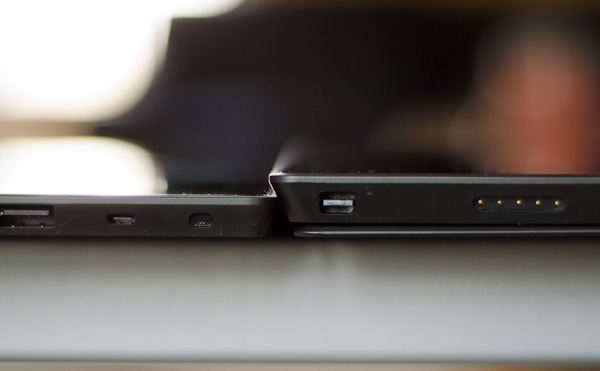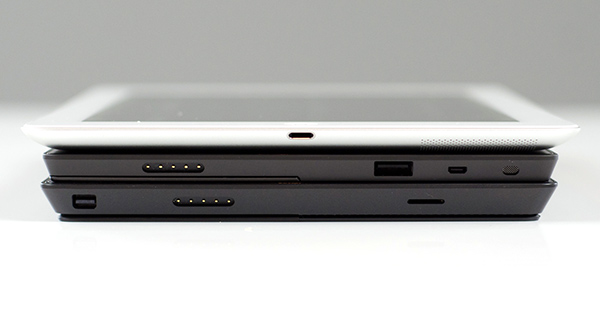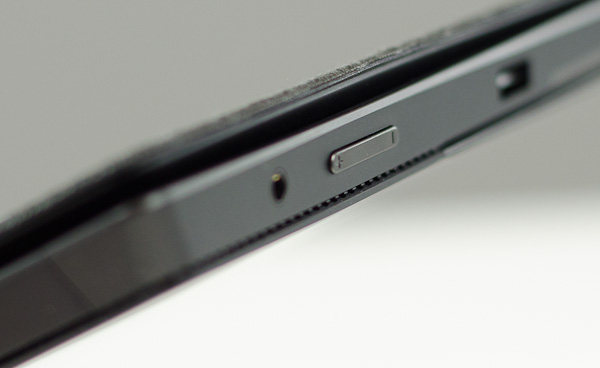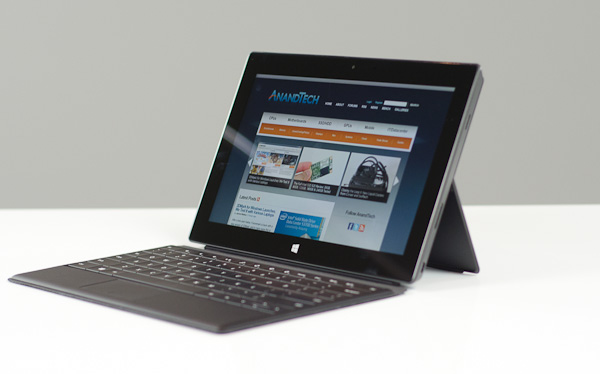Microsoft Surface Pro Review
by Anand Lal Shimpi on February 5, 2013 9:00 PM ESTSurface Pro Design
When I first saw Surface Pro, the Microsoft rep giving me the demo did a simple test. He stood Surface Pro right next to Surface, with the same start screen, and asked me if I could tell the two apart. The planar dimensions of Surface Pro are identical to Surface RT. Both feature the same sized 10.6-inch display, the same capacitive Windows button and the same 1-inch border around the screen. Looking head on, the only way you can tell the difference between Surface Pro and RT is the former’s 1080p display does make text a bit sharper.

Surface RT (left) vs Surface Pro (right)
Turn the two tablets to the side and the differences quickly become evident. Surface Pro is over 40% thicker than Surface RT (13.7mm vs 9.3mm). While the latter was of a similar thickness to an iPad with Retina Display, Surface Pro is clearly in a different league of dimensions.
The thickness of Surface Pro doesn’t really impede its portability, but the weight definitely makes it a lot less pleasant to carry around. Surface RT was already heavier than the competition but it hid its weight well. Surface Pro is just heavy for a tablet. I wasn’t originally impressed by the Surface RT form factor, but in switching between the RT and Pro models I immediately wish that Surface Pro came in the RT chassis and Surface RT came in something even thinner and lighter.

Surface Pro (left) vs. iPad 4 (right)

From top to bottom: iPad 4, Surface RT and Surface Pro
Shift the comparison to Ultrabooks however and all of the sudden Surface Pro seems quite light. It’s lighter than an 11-inch MacBook Air and Acer’s 11.6-inch Aspire S7 (although with optional keyboard cover it is heavier). It’s all about perspective. Compared to an iPad, Surface Pro is heavy, but compared to an Ultrabook or MacBook Air it’s light. The Pro model embodies the vision Microsoft had for the Surface family: to create a new type of device somewhere between a tablet and a notebook. That’s not to say there’s not room for improvement in the physical department. Surface Pro will likely go on a diet as it’s given more power efficient silicon, but even then you’ll always be able to build something thinner and lighter based on slower hardware, or go thicker and heavier with a notebook.
The fit and finish of Surface Pro are just as good as Surface RT. The tablet is built out of the same injection moulded Magnesium process (VaporMg) as Surface RT, however the chassis itself is somewhat simplified. While Surface RT featured three discrete VaporMg components (frame, back and kickstand), Surface Pro is made up of only two (single piece frame+back and kickstand). The result is no different to the end user, but the simplification on the assembly side is likely better for Microsoft.
I am fine laying the same praise on Surface Pro’s build quality as I did on Surface RT. The unique finish doesn’t feel like the aluminum we’re used to seeing on iPads, and definitely feels better than the plastic we’ve seen elsewhere. The VaporMg surface doesn’t feel like it would scratch easily, and after a few months with Surface RT I don’t see any visible scratches on my unit.
Surface Pro’s construction feels more utilitarian and understandably more oriented towards productivity, just like its little brother. I still believe that the Surface lineup is as much about Microsoft showing that it too can build high quality devices as it is about getting into the tablet market. If we compare it to the iPad, Surface Pro feels just as well built, if we compare it to every Windows RT and Windows 8 tablet or notebook on the market today - it’s worlds better. Say what you will about Microsoft entering the PC hardware business, but as of today Microsoft builds the best Windows RT and Windows 8 hardware on the market. If I ran a PC OEM I wouldn’t be angry at Microsoft, I’d be angry at myself for letting this happen.
Surface Pro retains the integrated kickstand from Surface RT, although the kickstand has been beefed up to accommodate the heavier tablet. Surface Pro’s kickstand keeps the device propped up at a fixed angle of 26-degrees away from the vertical axis. The rear facing camera is also angled to compensate (it shoots parallel to the ground with the kickstand opened).
The kickstand is allegedly good for over a million open/close cycles and it still doesn’t feel like something that would break. There are only two hinges in the kickstand compared to three for the RT model.
The kickstand on Surface Pro feels different than the kickstand on Suface RT. The Pro kickstand feels lighter and sounds less like metal and more like plastic if you tap on it. Feel around on the underside of the kickstand and you’ll notice a coating that seems to dampen sound and perhaps add some structure reinforcement to the design. Microsoft had to thicken the kickstand to support the added weight of the Surface Pro, but the difference is on the order of a fraction of a millimeter.
The tweaked kickstand does have different acoustics than Surface RT’s kickstand. While the latter sounded a lot like a thin metal door shutting, the Pro’s kickstand is far more muffled. I’d almost say it’s preferable.
Thankfully the kickstand’s functionality hasn’t been marginalized in the transition to the Pro. It’s still a highly integrated and very important part of the Surface experience. It’s simple to flip out and perfect for use on desks. You can make the kickstand work on your lap or chest if you’re lying down, but it’s not ideal for either unfortunately.
The more I use Surface (Pro and RT) the more I feel that Microsoft needs to pursue something a bit more flexible than the fixed 26-degree kickstand. The biggest issue by far is in-lap use with one of the keyboard covers attached. Depending on your seating position, the 26-degree angle that the kickstand opens at might be too small. Mechanically I don’t know the right solution for Microsoft but I do feel like for the kickstand to realize its true potential, it needs to be able to open and hold at multiple angles. It doesn’t necessarily need to have support for infinite angles, maybe even a few would work, but I do believe it’s necessary going forward.













228 Comments
View All Comments
kyuu - Thursday, February 7, 2013 - link
Lol? You only agree with Anand when he gives glowing reviews of Apple products.chizow - Wednesday, February 6, 2013 - link
I really like the idea behind Surface, but it just needs some refinement and improvements in hardware that only time and process fabrication brings.20% faster CPU speed, 50% better battery life, 40% smaller form factor, and 25% lower price ($700-750 range with a cover included) and I think Microsoft has a real winner here. Hopefully they aren't scared away by the RT's lackluster sales and stay on course with consistent upgrades for Surface.
I think the only questions now are...whether Microsoft will follow the insane 10-12 month upgrade cycle behind tables/smartphones, or the longer 18-24 month cycles of CPU/GPU. Or maybe they go the silent upgrade route similar to Alienware and Apple with their laptop offerings. Just silently upgrade components within the same model with major changes every few years.
I personall hope they go with the tablet/smartphone upgrade path because that means we'll get faster upgrades and increases in performance.
Jaerba - Wednesday, February 6, 2013 - link
Go on Newegg right now and find a laptop, any laptop regardless of size, that has 1080p resolution, a 100GB+ SSD and an i5 or i7. The closest you'll get are refurbed Zenbooks, and the rest are $1500+ offerings from Lenovo, Asus, Sony, etc.The pricing is simply not the issue, especially for the business user market. It's completely fair given the components.
chizow - Thursday, February 7, 2013 - link
Wrong, low power, small form factor Ultrabooks are in the same price range and even use most of the same components down to the CPU. Afterall, Microsoft is limited to common components and didn't get any special consideration from Intel for Surface.http://www.shopping.hp.com/en_US/home-office/-/pro...
As for the pricing, I'm not sure why you are comparing to Ultrabook, might as well compare it to the Titanic. Microsoft's entire reason for coming out with the Surface was to bridge the gap between the PC and tablet/mobile platforms, but in order to offer an appealing alternative, they can't price it like a PC, otherwise they'll share the same fate with that dying market.
Surface is going to compete against $200-$500 smart phones and tablets, not $1000-$1500 Ultrabooks, and as such, it needs to get closer to that $200-$500 price point.
althaz - Thursday, February 7, 2013 - link
I'm actually a lot more ok with the price than I am with some of the other compromises (but I accept most of them as nessecary for now).I think $799 for the 128Gb with a touch cover would be the perfect price and I DEFINITELY think the touch cover should be included in the $999 price, but at the end of the day it's certainly a FAIR price.
It's just not a great or even GOOD price.
kyuu - Thursday, February 7, 2013 - link
Comparing it with iOS and Android tabs is just ludicrous. It's not even in the same class of device. The tablet form factor does not dictate a low-performance, low-price device just because that's what you're used to.I would agree with Anand that a touch-/type-cover should be included for the price, though.
andrewaggb - Thursday, February 7, 2013 - link
agreed. Like anand said, the intel cpu alone is more than a nexus 7.And it uses a real SSD with 400MB/s reads, not emmc with 30MB/s.
It's not a great deal, but it's not a ripoff either. I don't consider price the issue at all on this one.
Surface RT on the other hand is overpriced.
chizow - Thursday, February 7, 2013 - link
No, it's not in the same class as iOS or Android devices in terms of hardware or even app/content compatibility, but that's the market it is competing with or hoping to cannibilize. People who want a portable cross-over device that gives them the flexibility and mobility of their tablets and smartphones with the power of their laptop/ultrabook.People will be asking themselves if they want to spend $200-400 on a iOS/Android tablet and a $500-600 laptop OR if they want to spend $1000 on a Surface + type pad. Many will find the combination of 2 devices suits their needs better than the Jack of all trades Master of None approach of the Surface.
Does the Surface do a good job of hitting it's mark? Yes. Does it do a good enough job to make you ditch your tablet/handheld OR your Ultrabook, or both? Probably not. It's not quite yet there in form factor, performance or price, imo. But I guess we will see how the market responds. I think it needs to drop to $700-$800 before it really takes off with at least 1 iteration of hardware improvements.
Doominated - Thursday, February 7, 2013 - link
Comparisons are made off of what the device can do, not what it looks like. What the Surface Pro does is in line with Ultrabooks, not with tablets. It just happens to look like a tablet.If you buy a mini-fridge that looks like a TV, are you going to start comparing it to TVs and what they can do, or to what mini-fridges can do? It's a pretty obvious answer.
chizow - Thursday, February 7, 2013 - link
What a device can do and what it looks like are integral to one another as form and function are synonymous. The edge the Surface has over other devices however is with content, applications and performance, you can get better compatibility and functionality in this regard but then you lose the tablet form factor and end up with an Ultrabook in terms of form factor and pricing.Ultimately, this device is going to be compared to tablets and smartphones because that's where the industry is going. Smaller, portable, handheld, easy to use, touch friendly devices. That's why the Surface exists, if not, we'd all be buying Ultrabooks. How many of you own Ultrabooks...how many of you want one?